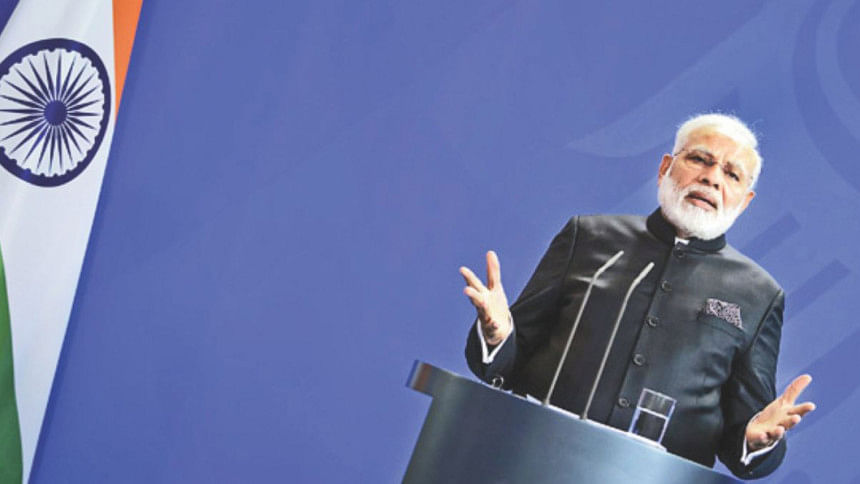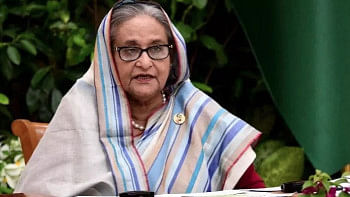Can Modi remake India?

Narendra Modi is a powerful phenomenon in Indian politics. Though he is not part of the traditional elites, either by caste or education, he has enormous energy. He has emerged out of the RSS, but seems to have a natural pragmatism and enough charisma to appeal to a wide range of voters, beyond a core of Hindutva enthusiasts.
In the 2014 elections he achieved a clear single party (BJP) majority in the Lok Sabha after a long period of coalition governments. The Congress Party emerged crippled. Its leadership had been weakened by division between economist Prime Minister Manmohan Singh and the Nehru/Gandhi dynasty represented by party president Sonia Gandhi.
Modi inherited an Indian economy still decades behind China and which, after an early 2011 peak growth of 9.2 percent, had again lost impetus. Despite a difficult financial legacy, but helped by lower world oil prices, Modi launched a range of reform initiatives and much-needed public investment in roads, rails and ports.
2016 saw widespread disruption from the sudden demonetisation of most of the country's banknotes. Success in passing a General Service Tax was largely spoilt by concessions to states reliant on border taxes for revenue. Growth slowed to 5.7 percent and economists wondered if Modi had overreached himself.
Nonetheless, state elections further consolidated Modi's dominance, especially control of the giant state of Uttar Pradesh. Digitalisation and the Aadhaar programme for mass personal bio-metric cards expanded the tax base and cut fraud and corruption so that anti-poverty projects could reach the poor. Private sector investment still stagnated but growth, foreign investment and the stock market all revived.
The 2018 budget promised a massive extension of health insurance for 100 million families and, amidst widespread agricultural distress, increased price support subsidies for farmers. Economic growth has now recovered to exceed that of a slowing China. The IMF forecasts 7.45 percent growth for 2018 and 7.8 percent for 2019.
So far quite impressive. But have Modi and the BJP peaked? In Modi's home state of Gujarat, Rahul Gandhi only narrowly lost a surprisingly strong Congress fight, leading a potent new mixture of Dalits and Muslims—as in Gujarat Rahul shrewdly visited temples to disarm Hindu suspicions. He is now Congress president. Modi realises that many vulnerable Muslims and middle-class voters have been alarmed by RSS and Hindutva extremists. The threat of Dalit/Muslim united opposition has led the RSS to call across caste barriers for Hindu solidarity.
The BJP has made progress in small northeast states, following its success in Assam, but other non-Congress regional parties, led by Sharad Pawar and Mamata Banerjee, are considering joining forces against the BJP. The next really big test will be the elections in Karnataka, the last large state still held by Congress.
In this context the huge banking scandal involving two diamond traders and the state-owned Punjab National Bank is a political setback for the Modi government. Is this just another failure of banking regulations and supervision or is it an indication that BJP government is as scandal-prone as its predecessors? The state banks' longstanding burden of non-performing loans (often made under political pressure) has had to be eased by re-capitalisation using taxpayers' money. Tighter regulation is promised and the new bankruptcy law will start to free up industrial resources by dissolving "zombie firms". But will Modi and Jaitley dare to go further and reverse Indira Gandhi's bank nationalisation?
As the mobile phone information revolution spreads so do aspirations for better jobs and living standards. Many are realising that too much of national wealth belongs to the elite. Underemployment is a major issue. Thirteen million people join the labour market every year. Modi has not lived up to his promise of an extra 10 million jobs. Casual labour far exceeds the minority of salaried workers, half of whom are civil servants. Economists point to the long-recognised need to reform India's over-rigid labour laws which hold back job creation, but even Modi, despite his Lok Sabha majority, has not yet challenged trade union resistance.
How have Modi and the BJP government performed in foreign and security policy? There has again been no lack of energy. Modi has travelled widely, including a recent focus on West Asia to help ensure India's oil and gas imports and remittance flows. Development of Chabahar port on the Iranian coast, plus a new rail link, will open up a trading route to Afghanistan, Iran and Central Asia bypassing Pakistan.
The Kashmir situation and relations with Pakistan and China remain problematic. Defence spending is being expanded, including on the logistics for defence against another Doklam challenge, but China can afford to spend three times as much. The muted response to calls for military intervention in Maldives shows India's need for caution. Permanent membership of the UNSC remains as far off as ever.
It remains to be seen if the Quad negotiations with Australia, US and Japan can succeed in forming an "alternative" to China's OBOR and preserve India's naval dominance in the Indian Ocean. China has a military base in Djibouti, Gwadar (Pakistan coast), Sri Lanka and Maldives. India has naval facilities in Mauritius and an agreement with Seychelles. But how far can India still rely on American backing in the event of a serious military clash with China? Fortunately, neither China nor India wants that risk.
So, can Modi remake India? He does not have the power Xi Jinping commands and it is no easy task to steer and accelerate social and development change in a democratic federal structure of 1.3 billion people, particularly given India's many languages, religions and ancient traditions. There have been setbacks. Demonetisation may have been a mistake. Modi is not a miracle worker.
Nevertheless, a lot has been achieved in four years, though observers point out that in his drive for "inclusive development" he has been greatly helped by the development initiatives of the last government, particularly Aadhaar and digitalisation. Some other existing projects have been little more than renamed and were started by Congress.
We shall see, but opinion surveys suggest that Modi's personal popularity remains high—enough to achieve a second mandate in 2019.
Selina Mohsin is a former ambassador.





Comments